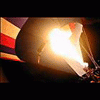Penguin., on Jan 6 2007, 11:39 PM, said:
Try again.
think about that....do the floats spin freely? if your seaplane does.. u need a new one........
again, the water will push against the seaplanes floats, causing.. hmm whats that word? DRAG?? or something like that, i don't know....... what happens when u have that??? explan to me that mister sea plane rating??
if the force of the water is equal to the thrust of the prop.. u aren't going anywhere, think about it, what would happen if u shut off the engine on a seaplane? you would start to float away with the current correct?? why is that?? because the water pulls the plane with it....
now i doubt ud ever come into that situation where the current was stronger then the thrust of the aircraft, but, in theory.. the water would stop it from happening if it could....
a sea plane has a rudder on each float does it not? why??? because the movemnt of the water flow affects the movment of the aircraft.......... same concept.... if the water is causing to much drag, then the plane isnt going anywhere......





















